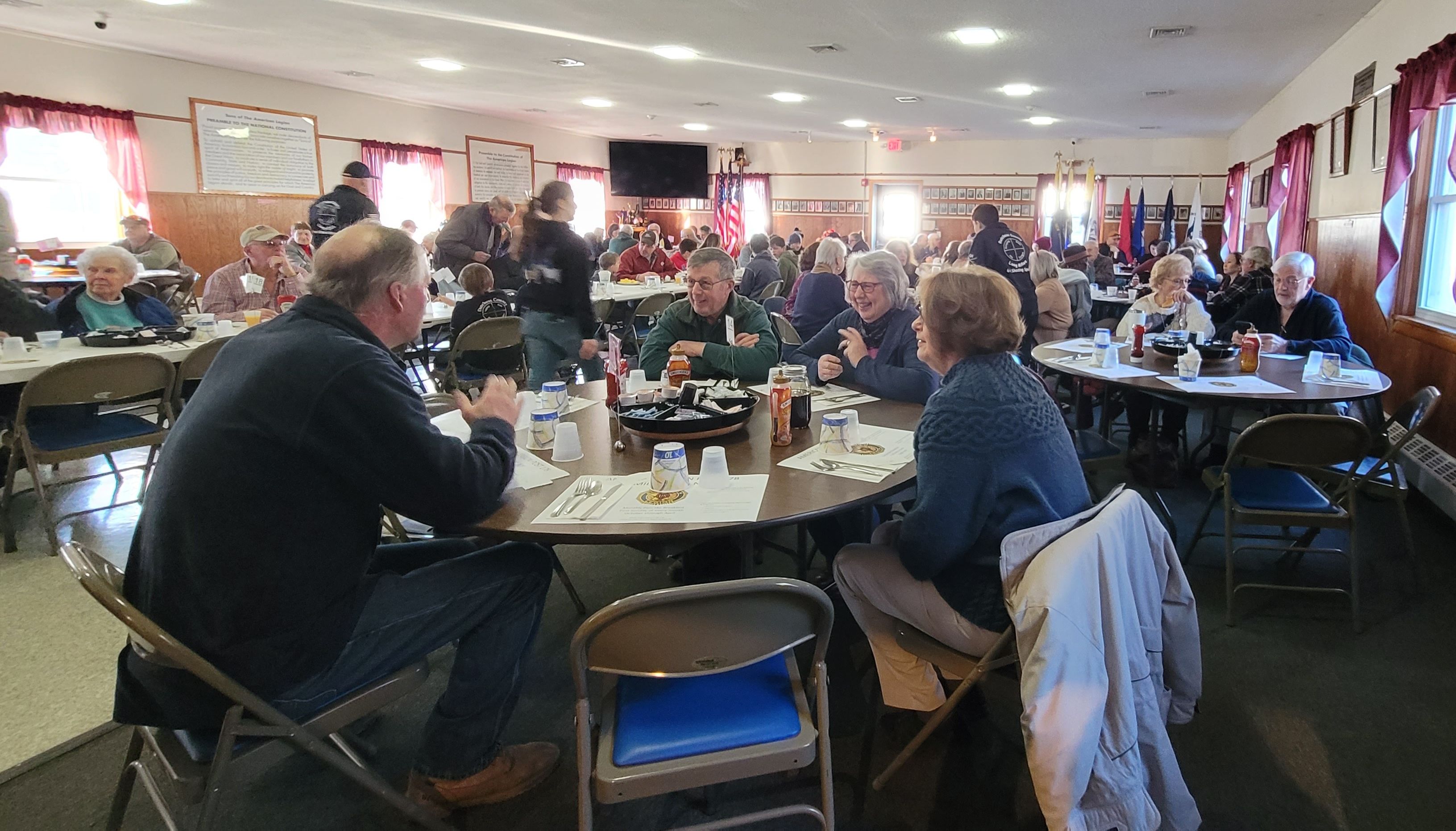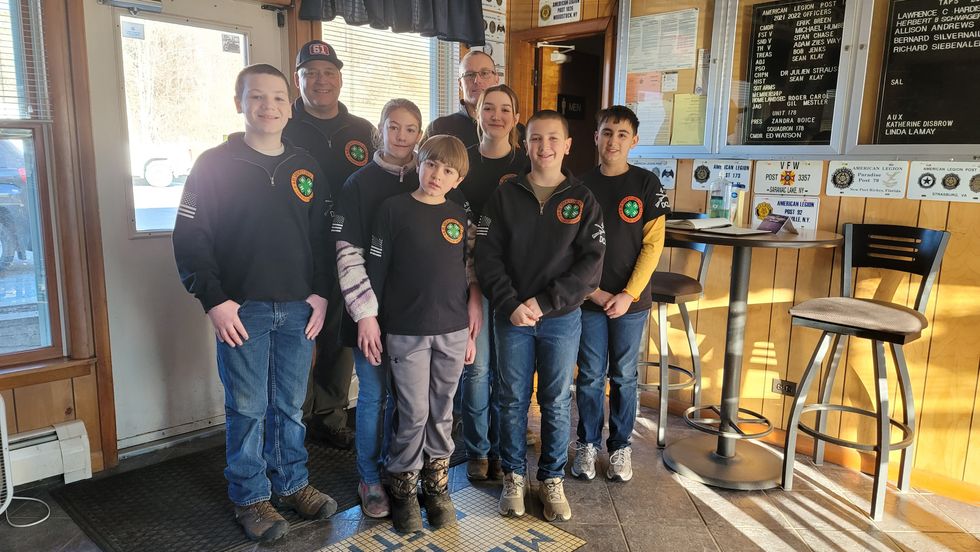Gunning for gold: 4-H rifle club teaches marksmanship and service

200 people attended the Post’s February pancake breakfast.
Judith O’Hara Balfe

200 people attended the Post’s February pancake breakfast.
MILLERTON — Youths in Dutchess County Long Rifle club (DCLR) 4-H T-shirts bustled among some of the 200 people who gathered for the monthly pancake breakfast hosted by the American Legion Post 178, serving breakfast, coffee and orange juice on a cold but sunny Sunday, Feb. 4.
4-H Clubs typically bring to mind barn animals, farming, perhaps some crafting skills — shooting and firearms, not so much.
Nevertheless, the DCLR is a shooting sports club organized as part of the Cornell Cooperative Extension Dutchess County (CCEDC) in Millbrook, and a 501(c)(3) nonprofit educational organization with a 4-H club.
The DCLR is sponsored by American Legion Post 178 in Millerton. The club meets about twice each month and range nights are held at various locations within Dutchess County, usually on Tuesday evenings and occasionally on Saturdays.
Jane Rodd, 4-H leader at CCEDC, explained at the American Legion pancake breakfast what the program is about:
“When a young person is legally old enough to drive, you don’t let them drive without training. Well, at 18, one is old enough to buy a gun. Shouldn’t he or she be trained in how to safely use it?”
Aside from learning how to shoot, these young people also learn about public service, about being responsive to the needs of others, she said, watching the 4-Hers go smiling about their duties at the pancake breakfast, making polite conversation with the diners.
Brodie Read is 12, home-schooled, and says he started in 4-H at the age of 8. He likes working the American Legion breakfasts because it gives him a chance to help others, to spend time with his friends, and he also gets a free breakfast. He comes from Milan to perform his service, from 7 a.m. to 10 a.m.
At the age of 13, Addison Staph is in eighth grade at Stissing Mountain Junior/Senior High School in Pine Plains, and joined this group at the age of 10. Her father joined the team as an instructor at the same time, so they spend quality time together as well as with other team members.
Learning self defense and basic safety rules was important to her, she said.
Though hesitant to join at first because she thought she might be the only girl, Addison was pleasantly surprised to find that there were many young ladies who also wanted to learn to shoot. She likes that she gets to meet different people, and that there is so much support in the community. When reminded that the group had been awarded 26 scholarships last year,and that 24 of them went to girls, she smiled.
“Girls have good hand and eye coordination,” she said.

The group uses the term “firearms,” not “guns” or “weapons.”
The typical age range for a 4-H group is 5-19, but New York’s penal code sets the age for this group at 8-19. At the age of 8, a child can begin to learn archery. At 9, they can move to air rifles; air pistols at 10; and at the age of 12, they are considered ready for rifles, muzzle loaders and shotguns. At 14, they are allowed to move up to pistols.
According to the program, each discipline teaches safety, concentration, self-discipline, self-confidence, goal-setting, decision-making and courtesy as the 4-Hers cover the basics and build toward more advanced skills. The youths are introduced to local policies, regulations, laws and ethical behavior by repeated demonstration and through personal practice.
What the young people gain, said Rodd, is cooperative and competitive skills, leadership skills, safe habits, self-discipline and self-esteem. She said they also learn personal responsibility, ethics, sportsmanship, confidence, concentration and poise. The club gives them opportunities to set and achieve goals, earn awards and scholarships, and to learn about future careers.
Bob Jenks, who leads the program, mentioned that shooting is a recognized Olympic sport.
“Gun safety is one of the main purposes” of the 4-H club, he stated, “and learning life skills. There are more girls than boys who want to learn, and girls become mothers, so that’s important.”
Both Jenks and Rodd mentioned that in an area where many hunt, learning to properly shoot means more safety when in the woods, and, in theory, more humane hunting practices. 4-Hers are always taught to work within the legal framework.
Jenks said that before COVID-19, there were 260 4-H members in the Long Rifle club, but it dwindled to about 100. Now, the numbers are rising once again, and there are currently 230 young people involved.
Most of them enjoy working the monthly American Legion breakfasts, but the limit for volunteers is capped at 20.
For more information about this group, go to www.dclongrifles.org. For information about the American Legion breakfasts, call 518-789-4755.
Mad Rose Gallery on Route 44 in the Village of Millerton is decked out with lights and decorations to celebrate the holiday season.
MILLERTON — The Village of Millerton is inviting residents and businesses to enter its annual house decorating contest, with judging now underway through Dec. 28.
Awards will be presented in several categories, including Best Lights, Most Creative, Best Overall and Best Commercial Front.
Entries will be evaluated by a panel of judges using established criteria. Creativity will be judged based on originality, variety of materials used and the use of homemade vs. commercially made decorations. Appearance will consider color coordination, balance and overall attractiveness, while effort will reflect the time and energy put into preparation and presentation.
Judging will be conducted by drive-by observation between 6 p.m. and 11 p.m., and displays must be clearly visible from the street side of the house at night. People and pets may not be included as part of the design.
Winners in each category will receive a gift basket, gift certificates and recognition in The Millerton News. Awards will be distributed on Friday, Jan. 9, 2026.
The contest is open to residents and businesses in the Village of Millerton and the Town of North East. Entry forms can be obtained from Village Hall or at villageofmillerton-ny.gov.
The Upstate Celtic Allstars perform celtic versions of holiday tunes at Amenia Town Hall on Dec. 15, 2024.
AMENIA — Fast becoming a local holiday tradition, the Amenia Town Recreation Department is presenting a free concert by the Upstate Celtic Allstars on Saturday, Dec. 20, at the Amenia Town Hall Auditorium, beginning at 2 p.m.
The five-member Celtic Allstars ensemble will rouse the audience to holiday cheer with a varied program of holiday tunes and rhythmic dance numbers. Appearing in the ensemble are Vermont’s Claudine Langille, vocals and banjo; Dave Paton, hammer dulcimer and concertina, Isa Simon, fiddle and vocals; Joseph Sobol, contemporary cittern (related to guitar); and Ambrose Verdibello, fiddle and guitar.
Refreshments will be served during intermission. Bring the whole family to revel in the lively festivities.